
BABY QUILTS
33 Adorable Designs to Sew for Little Ones Amelia Johanson, Editor Quilts by Wendy Sheppard, Lynette Jensen, Suzanne McNeill, Choly Knight, Mary M. Hogan, and other top quilters
 Sooo Big! Baby Quilts
Sooo Big! Baby Quilts Landauer Publishing, www.landauerpub.com, is an imprint of Fox Chapel Publishing Company, Inc. Copyright 2021 by Fox Chapel Publishing Company, Inc., 903 Square Street, Mount Joy, PA 17552. All rights reserved. No part of this book may be reproduced, stored in a retrieval system, or transmitted in any form or by any means, electronic, mechanical, photocopying, recording, or otherwise, without the prior written permission of Fox Chapel Publishing, except for the inclusion of brief quotations in an acknowledged review and the enlargement of the template patterns in this book for personal use only. The patterns themselves, however, are not to be duplicated for resale or distribution under any circumstances.
Any such copying is a violation of copyright law. Project Team Editorial Director: Kerry Bogert Editor: Amy Deputato Copy Editor/Indexer: Jean Bissell Designer: Wendy Reynolds Print ISBN 9781947163713
eISBN: 9781637410608 We are always looking for talented authors. To submit an idea, please send a brief inquiry to acquisitions@foxchapelpublishing.com. For a printable PDF of the patterns used in this book, please contact Fox Chapel Publishing at , with 9781947163713 Sooo Big! Baby Quilts in the subject line.
Contents
Introduction
There is such joy in making a baby quilt. Not only are the excitement and anticipation of welcoming a new little one infused into every stitch, but there are so few parameters to making it right.
You wont find a baby in the world who is going to worry about whether its 66" x 35", 40" x 60", or any size in between. Baby quilts, unlike bed quilts, dont have to be sized properly to fit a mattress. In fact, in these modern times, baby quilts, which were traditionally called crib quilts, usually end up being tossed in the crib or port-a-bed when baby isnt in it.) serve to stimulate babys development. Best of all, baby quilts are just as satisfying to make as larger quilts! You will still pore over selecting the perfect fabrics to go with just the right pattern, yet, because of the smaller size, you can perhaps indulge a bit in the materials or will even have time to make more than one. Youll find thirty-three baby quilts in these pages, designed by some of our top quilting authors through the years. This is a beautiful collection that incorporates a variety of techniques and design styles while appealing to quilters of all skill levels.
Youre sure to find just the pattern youve been looking for.
| Metric Conversion Chart |
| TO CONVERT | TO | MULTIPLY BY |
| Inches | Centimeters | 2.54 |
| Centimeters | Inches | 0.4 |
| Feet | Centimeters | 30.5 |
| Centimeters | Feet | 0.03 |
| Yards | Meters | 0.9 |
| Meters | Yards | 1.1 |

__________________________ The American Academy of Pediatrics (AAP) recommends keeping soft objects and loose bedding out of the babys sleeping area for at least the first twelve months. This recommendation is based on data around infant sleep deaths and guidelines for reducing the risk of SIDS.
Helpful Tips
Basic Cutting Instructions
Tips for Accurate Cutting
Accurate cutting is easy when using a rotary cutter with a sharp blade, a cutting mat, and a transparent ruler. Begin by pressing your fabric and then follow these steps:
Folding
Fold the fabric with the selvage edges together. Smooth the fabric flat.
If needed, fold again to make your fabric length shorter than the length of the ruler. Align the fold with one of the guide lines on the mat. This is important to avoid getting a kink in your strip.
Cutting
Align the ruler with a guide line on the mat. Press down on the ruler to prevent it from shifting or have someone help hold the ruler. Hold the rotary cutter along the edge of the ruler and cut off the selvage edge.
Also using the guide line on the mat, cut the ends straight. Cut strips for making the quilt top on the crosswise grain (from selvage to selvage) or on the grain (parallel to the selvage edge). If possible, cut strips for the borders on the grain to prevent wavy edges and make quilting easier. Tip: When cutting strips, move the ruler, not the fabric.
Rotary Cutter Safety
A rotary cutter is a wonderful and useful tool. When not used correctly, the sharp blade can be dangerous.
Follow these safety tips: Never cut toward you. Use a sharp blade. Pressing harder on a dull blade can cause the blade to jump the ruler and injure your fingers. Always disengage the blade before the cutter leaves your hand, even if you intend to pick it up again immediately. A rotary cutter can get caught on fabric and fall to the floor, cutting feet, legs, or fingers on the way.
Pre-Cut Strips Tips
Pre-cut strips are cut on the crosswise grain and are prone to stretching.
These tips will help reduce stretching and make your quilt lay flat for quilting. If you are cutting yardage, cut on the grain. When sewing crosswise grain strips together, take care not to stretch the strips. If you detect any puckering as you go, rip out the seam and sew it again. Press. Do not iron.
Carefully open fabric, with the seam to one side, and press without moving the iron. A back-and-forth ironing motion stretches the fabric. Reduce the wiggle in your borders with this technique from garment making: First, accurately cut your borders to the exact measurements of the quilt top. Then, before sewing the border to the quilt, run a double row of stay stitches along the outside edge to maintain the original shape and prevent stretching. Pin the border to the quilt, taking care not to stretch the quilt top to make it fit.
Matching Edges
Carefully line up the edges of your strips.
Matching Edges
Carefully line up the edges of your strips.
Many times, if the underside is off a little, your seam will be off by ". This does not sound like much until you have eight seams in a block, each off by ". Now your finished block is a whole inch wrong! Pin the pieces together to prevent them from shifting.
Seam Allowance
I cannot stress enough the importance of accurate seams. Many of the quilts in this book are measured for " seams, but the seam allowance is indicated with each project. Most sewing machine manufacturers offer a " foot.
Because " seams are so common in quilting, a " foot is a very worthwhile investment.
Sewing Bias Edges
Bias edges wiggle and stretch out of shape very easily. They are not recommended for beginners, but even a novice can accomplish bias edges if the following techniques are employed: Stabilize the bias edge with one of these methods: a) Press with spray starch. b) Press freezer paper or removable iron-on stabilizer to the back of the fabric. c) Sew a double row of stay stitches along the bias edge and " from the bias edge. This is a favorite technique of garment makers.

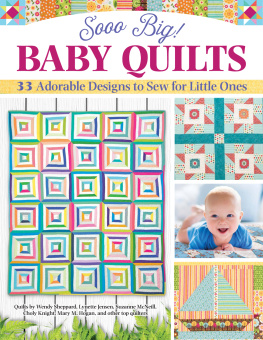
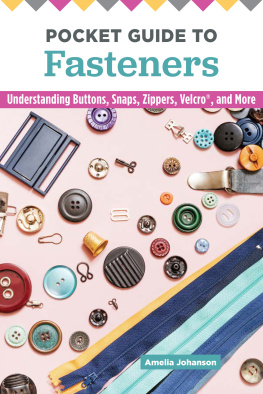
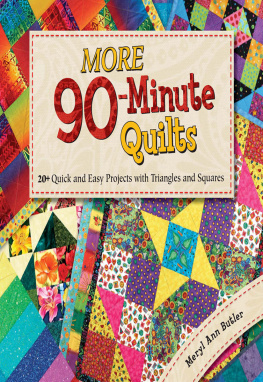
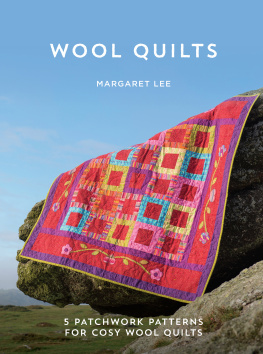
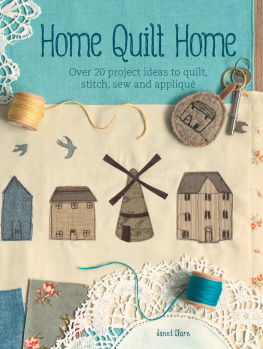
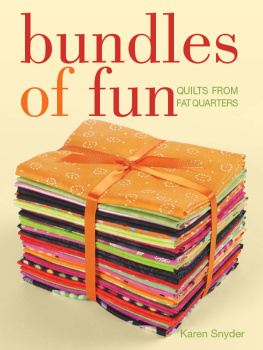

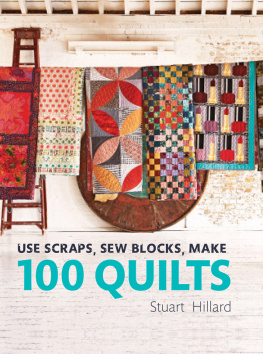
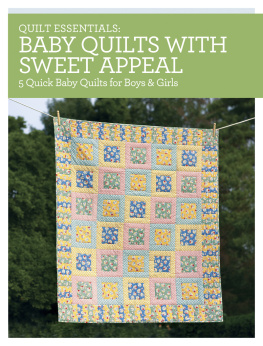
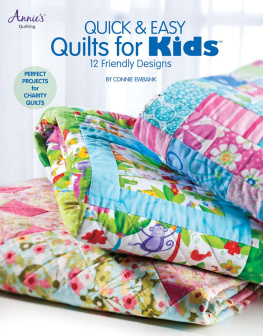
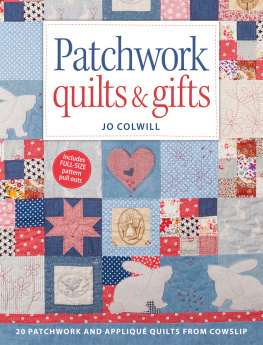
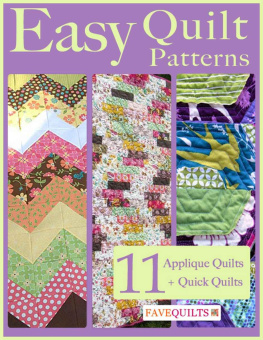


 Sooo Big! Baby Quilts Landauer Publishing, www.landauerpub.com, is an imprint of Fox Chapel Publishing Company, Inc. Copyright 2021 by Fox Chapel Publishing Company, Inc., 903 Square Street, Mount Joy, PA 17552. All rights reserved. No part of this book may be reproduced, stored in a retrieval system, or transmitted in any form or by any means, electronic, mechanical, photocopying, recording, or otherwise, without the prior written permission of Fox Chapel Publishing, except for the inclusion of brief quotations in an acknowledged review and the enlargement of the template patterns in this book for personal use only. The patterns themselves, however, are not to be duplicated for resale or distribution under any circumstances.
Sooo Big! Baby Quilts Landauer Publishing, www.landauerpub.com, is an imprint of Fox Chapel Publishing Company, Inc. Copyright 2021 by Fox Chapel Publishing Company, Inc., 903 Square Street, Mount Joy, PA 17552. All rights reserved. No part of this book may be reproduced, stored in a retrieval system, or transmitted in any form or by any means, electronic, mechanical, photocopying, recording, or otherwise, without the prior written permission of Fox Chapel Publishing, except for the inclusion of brief quotations in an acknowledged review and the enlargement of the template patterns in this book for personal use only. The patterns themselves, however, are not to be duplicated for resale or distribution under any circumstances.  __________________________ The American Academy of Pediatrics (AAP) recommends keeping soft objects and loose bedding out of the babys sleeping area for at least the first twelve months. This recommendation is based on data around infant sleep deaths and guidelines for reducing the risk of SIDS.
__________________________ The American Academy of Pediatrics (AAP) recommends keeping soft objects and loose bedding out of the babys sleeping area for at least the first twelve months. This recommendation is based on data around infant sleep deaths and guidelines for reducing the risk of SIDS.